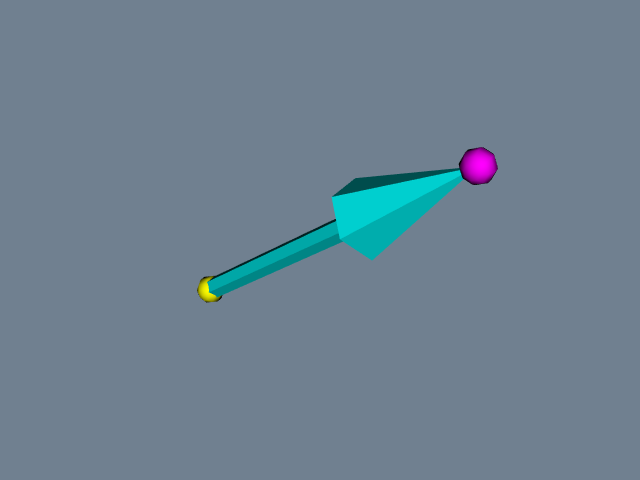GLTFExporter
vtk-examples/Cxx/IO/GLTFExporter
Description¶
The examples uses vtkGLTFExporter to save the current scene in a .gltf file. The saved file called GLTFExporter.gltf is saved in the directory where the example is run. That file can be imported using vtkGLTFImporter.
Warning
Currently the camera is not writeen properly so the exported scene will not match the imported scene.
Question
If you have a question about this example, please use the VTK Discourse Forum
Code¶
GLTFExporter.cxx
#include <vtkActor.h>
#include <vtkArrowSource.h>
#include <vtkCamera.h>
#include <vtkGLTFExporter.h>
#include <vtkInteractorStyleTrackballCamera.h>
#include <vtkMath.h>
#include <vtkMinimalStandardRandomSequence.h>
#include <vtkNamedColors.h>
#include <vtkNew.h>
#include <vtkPolyDataMapper.h>
#include <vtkProperty.h>
#include <vtkRenderWindow.h>
#include <vtkRenderWindowInteractor.h>
#include <vtkRenderer.h>
#include <vtkSphereSource.h>
#include <vtkTransform.h>
#include <vtkTransformPolyDataFilter.h>
#include <array>
int main(int argc, char* argv[])
{
if (argc < 2)
{
std::cout << "Usage: GLTFExporter file.gltf e.g. GLTFExporter.gltf"
<< std::endl;
return EXIT_FAILURE;
}
vtkNew<vtkNamedColors> colors;
// Set the background color.
vtkColor3d backgroundColor = colors->GetColor3d("SlateGray");
// Create an arrow.
vtkNew<vtkArrowSource> arrowSource;
// Generate a random start and end point
double startPoint[3];
double endPoint[3];
vtkNew<vtkMinimalStandardRandomSequence> rng;
rng->SetSeed(8775070); // For testing.
for (auto i = 0; i < 3; ++i)
{
rng->Next();
startPoint[i] = rng->GetRangeValue(-10, 10);
rng->Next();
endPoint[i] = rng->GetRangeValue(-10, 10);
}
// Compute a basis
double normalizedX[3];
double normalizedY[3];
double normalizedZ[3];
// The X axis is a vector from start to end
vtkMath::Subtract(endPoint, startPoint, normalizedX);
double length = vtkMath::Norm(normalizedX);
vtkMath::Normalize(normalizedX);
// The Z axis is an arbitrary vector cross X
double arbitrary[3];
for (auto i = 0; i < 3; ++i)
{
rng->Next();
arbitrary[i] = rng->GetRangeValue(-10, 10);
}
vtkMath::Cross(normalizedX, arbitrary, normalizedZ);
vtkMath::Normalize(normalizedZ);
// The Y axis is Z cross X
vtkMath::Cross(normalizedZ, normalizedX, normalizedY);
vtkNew<vtkMatrix4x4> matrix;
// Create the direction cosine matrix
matrix->Identity();
for (auto i = 0; i < 3; i++)
{
matrix->SetElement(i, 0, normalizedX[i]);
matrix->SetElement(i, 1, normalizedY[i]);
matrix->SetElement(i, 2, normalizedZ[i]);
}
// Apply the transforms.
vtkNew<vtkTransform> transform;
transform->Translate(startPoint);
transform->Concatenate(matrix);
transform->Scale(length, length, length);
// Transform the polydata.
vtkNew<vtkTransformPolyDataFilter> transformPD;
transformPD->SetTransform(transform);
transformPD->SetInputConnection(arrowSource->GetOutputPort());
// Create a mapper and actor for the arrow.
vtkNew<vtkPolyDataMapper> mapper;
vtkNew<vtkActor> actor;
#ifdef USER_MATRIX
mapper->SetInputConnection(arrowSource->GetOutputPort());
actor->SetUserMatrix(transform->GetMatrix());
#else
mapper->SetInputConnection(transformPD->GetOutputPort());
#endif
actor->SetMapper(mapper);
actor->GetProperty()->SetColor(colors->GetColor3d("Cyan").GetData());
// Create spheres for start and end point.
vtkNew<vtkSphereSource> sphereStartSource;
sphereStartSource->SetCenter(startPoint);
sphereStartSource->SetRadius(0.8);
vtkNew<vtkPolyDataMapper> sphereStartMapper;
sphereStartMapper->SetInputConnection(sphereStartSource->GetOutputPort());
vtkNew<vtkActor> sphereStart;
sphereStart->SetMapper(sphereStartMapper);
sphereStart->GetProperty()->SetColor(colors->GetColor3d("Yellow").GetData());
vtkNew<vtkSphereSource> sphereEndSource;
sphereEndSource->SetCenter(endPoint);
sphereEndSource->SetRadius(0.8);
vtkNew<vtkPolyDataMapper> sphereEndMapper;
sphereEndMapper->SetInputConnection(sphereEndSource->GetOutputPort());
vtkNew<vtkActor> sphereEnd;
sphereEnd->SetMapper(sphereEndMapper);
sphereEnd->GetProperty()->SetColor(colors->GetColor3d("Magenta").GetData());
// Create a renderer, render window, and interactor.
vtkNew<vtkRenderer> renderer;
vtkNew<vtkRenderWindow> renderWindow;
renderWindow->AddRenderer(renderer);
renderWindow->SetSize(640, 480);
renderWindow->SetWindowName("GLTFExporter");
vtkNew<vtkInteractorStyleTrackballCamera> style;
vtkNew<vtkRenderWindowInteractor> renderWindowInteractor;
renderWindowInteractor->SetRenderWindow(renderWindow);
renderWindowInteractor->SetInteractorStyle(style);
// Add the actor to the scene.
renderer->AddActor(actor);
renderer->AddActor(sphereStart);
renderer->AddActor(sphereEnd);
renderer->SetBackground(backgroundColor.GetData());
// Render and interact.
renderWindow->Render();
renderer->GetActiveCamera()->Azimuth(30);
renderer->GetActiveCamera()->Elevation(30);
renderer->ResetCameraClippingRange();
renderWindowInteractor->Start();
vtkNew<vtkGLTFExporter> writer;
writer->SetFileName(argv[1]);
writer->InlineDataOn();
writer->SetRenderWindow(renderWindow);
writer->Write();
return EXIT_SUCCESS;
}
CMakeLists.txt¶
cmake_minimum_required(VERSION 3.12 FATAL_ERROR)
project(GLTFExporter)
find_package(VTK COMPONENTS
CommonColor
CommonCore
CommonTransforms
FiltersGeneral
FiltersSources
IOExport
IOExportOpenGL2
IOExportPDF
InteractionStyle
RenderingContextOpenGL2
RenderingCore
RenderingFreeType
RenderingGL2PSOpenGL2
RenderingOpenGL2
)
if (NOT VTK_FOUND)
message(FATAL_ERROR "GLTFExporter: Unable to find the VTK build folder.")
endif()
# Prevent a "command line is too long" failure in Windows.
set(CMAKE_NINJA_FORCE_RESPONSE_FILE "ON" CACHE BOOL "Force Ninja to use response files.")
add_executable(GLTFExporter MACOSX_BUNDLE GLTFExporter.cxx )
target_link_libraries(GLTFExporter PRIVATE ${VTK_LIBRARIES}
)
# vtk_module_autoinit is needed
vtk_module_autoinit(
TARGETS GLTFExporter
MODULES ${VTK_LIBRARIES}
)
Download and Build GLTFExporter¶
Click here to download GLTFExporter and its CMakeLists.txt file. Once the tarball GLTFExporter.tar has been downloaded and extracted,
cd GLTFExporter/build
If VTK is installed:
cmake ..
If VTK is not installed but compiled on your system, you will need to specify the path to your VTK build:
cmake -DVTK_DIR:PATH=/home/me/vtk_build ..
Build the project:
make
and run it:
./GLTFExporter
WINDOWS USERS
Be sure to add the VTK bin directory to your path. This will resolve the VTK dll's at run time.
